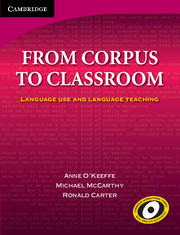Book contents
- Frontmatter
- Acknowledgements
- Contents
- Preface
- 1 Introduction
- 2 Establishing basic and advanced levels in vocabulary learning
- 3 Lessons from the analysis of chunks
- 4 Idioms in everyday use and in language teaching
- 5 Grammar and lexis and patterns
- 6 Grammar, discourse and pragmatics
- 7 Listenership and response
- 8 Relational language
- 9 Language and creativity: creating relationships
- 10 Specialising: academic and business corpora
- 11 Exploring teacher corpora
- Coda
- References
- Appendix 1
- Appendix 2
- Appendix 3
- Author index
- Subject index
- Publisher's acknowledgements
2 - Establishing basic and advanced levels in vocabulary learning
Published online by Cambridge University Press: 23 December 2009
- Frontmatter
- Acknowledgements
- Contents
- Preface
- 1 Introduction
- 2 Establishing basic and advanced levels in vocabulary learning
- 3 Lessons from the analysis of chunks
- 4 Idioms in everyday use and in language teaching
- 5 Grammar and lexis and patterns
- 6 Grammar, discourse and pragmatics
- 7 Listenership and response
- 8 Relational language
- 9 Language and creativity: creating relationships
- 10 Specialising: academic and business corpora
- 11 Exploring teacher corpora
- Coda
- References
- Appendix 1
- Appendix 2
- Appendix 3
- Author index
- Subject index
- Publisher's acknowledgements
Summary
Introduction
In chapter 1 we outlined some of the basic corpus techniques, including the creation of frequency lists for single words, the generation of collocational statistics, information on the occurrence of clusters, and the use of concordances for the investigation of items in context. One of the most obvious things we can do with the first of these, frequency information, is to ascertain how many words native speakers use, how frequently they have recourse to the individual words they use and how they combine them, and to explore to what extent words have become part of regularly occurring chunks or clusters for the native user. In this chapter we look at some of this evidence and consider how relevant or useful it is for understanding the vocabulary needs of second language learners and for establishing benchmarks by which learners' vocabulary levels can be assessed and evaluated and by which we may come to some general agreement as to what constitutes the various levels of proficiency in vocabulary knowledge.
It is important to state from the outset, however, that just because native speakers can understand a particular number of words and use them in particular ways, it is not necessarily so that L2 learners must be judged solely against native-user standards. In other words, we must not view second language learners as ‘failed monolinguals’, as Cook (1998) aptly puts it.
Information
- Type
- Chapter
- Information
- From Corpus to ClassroomLanguage Use and Language Teaching, pp. 31 - 57Publisher: Cambridge University PressPrint publication year: 2007
